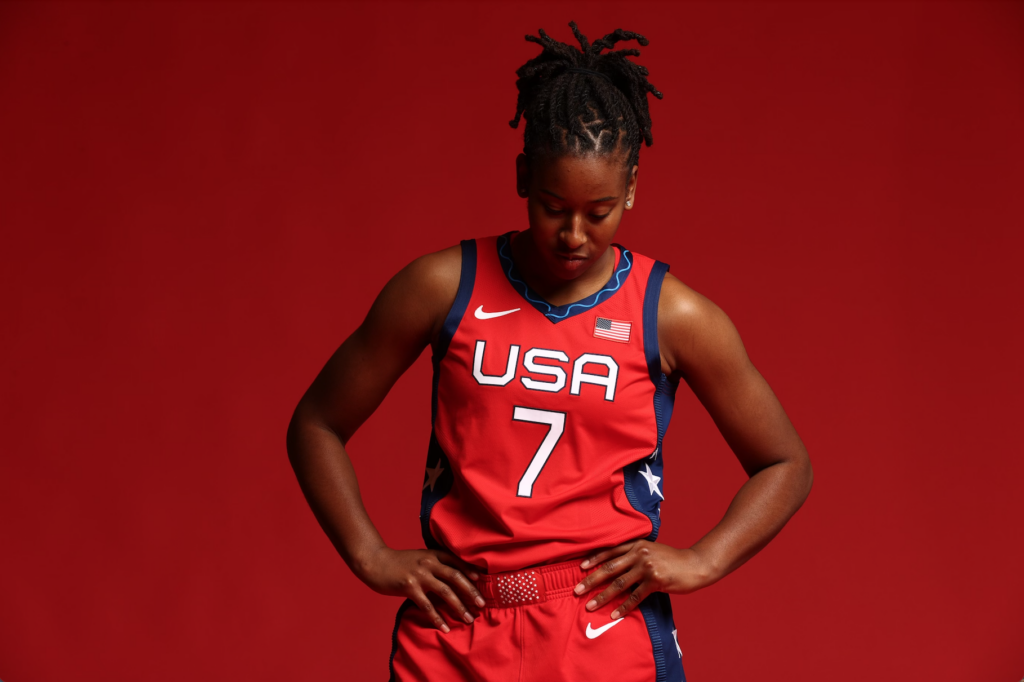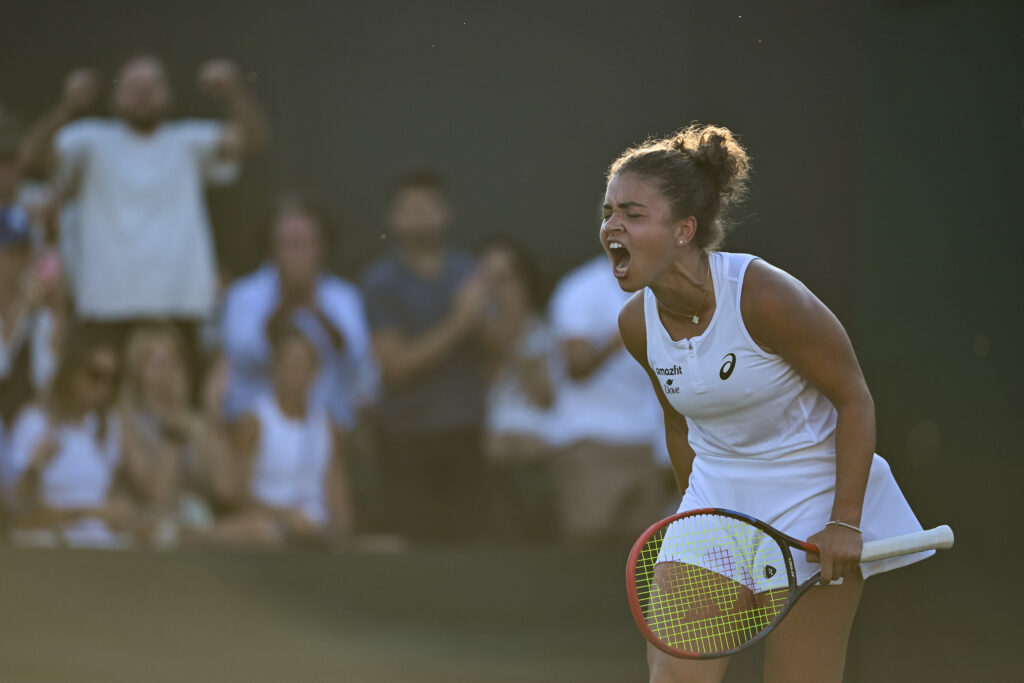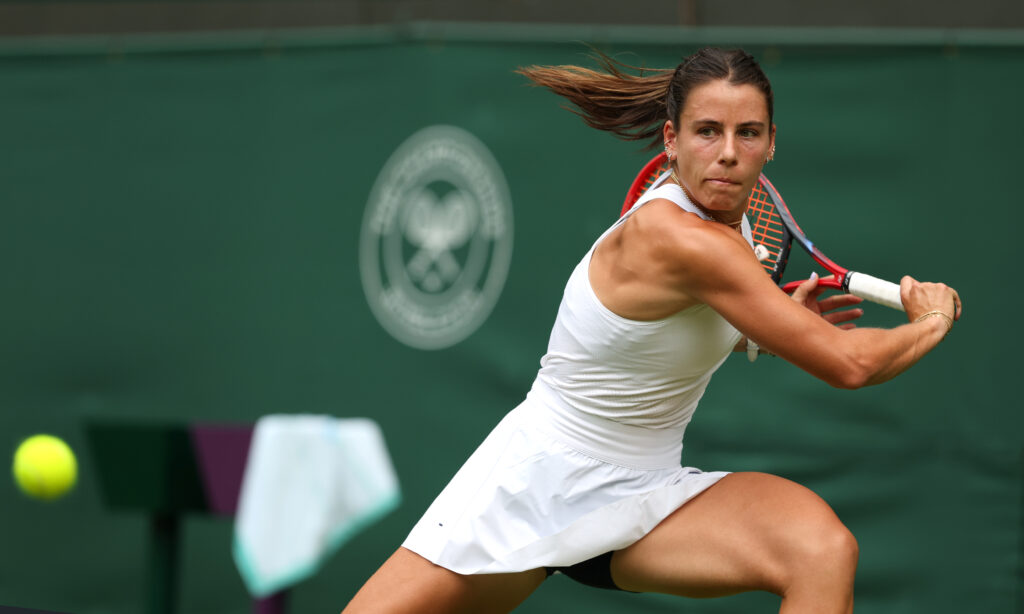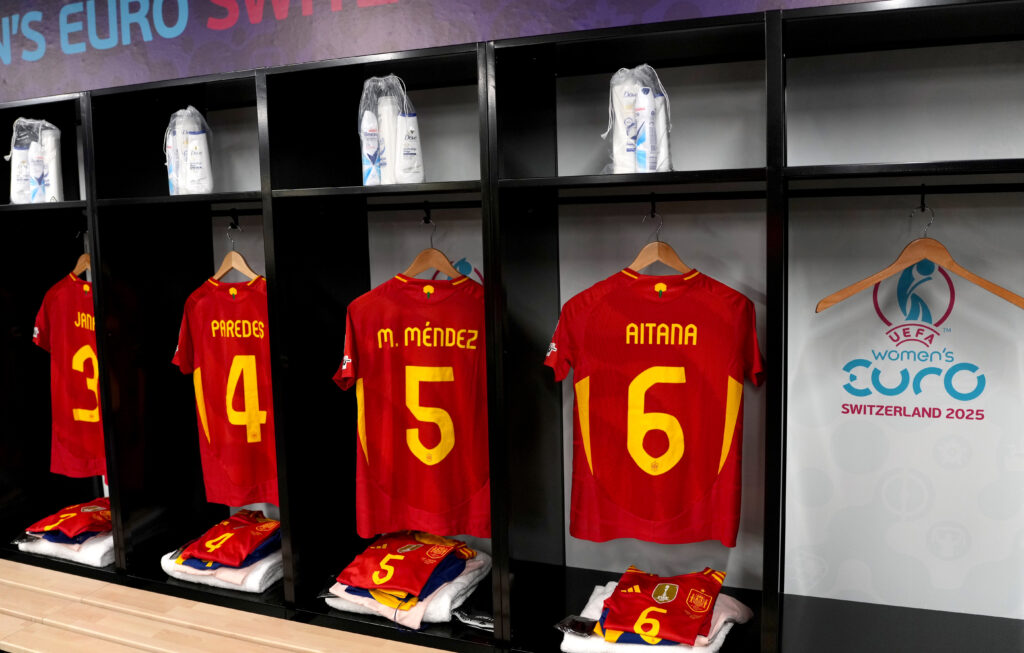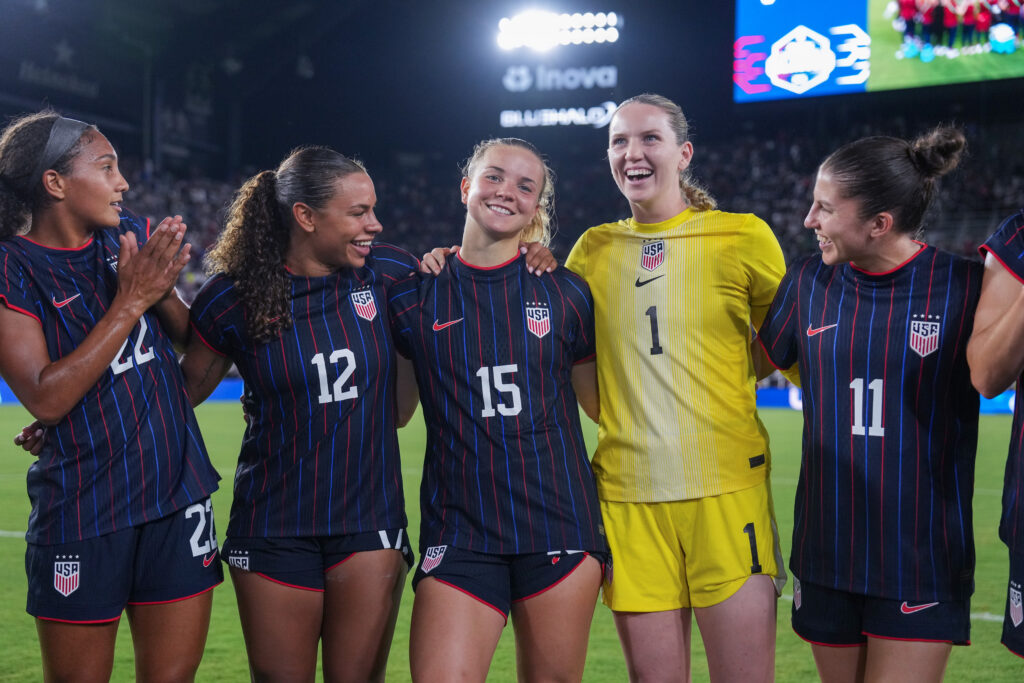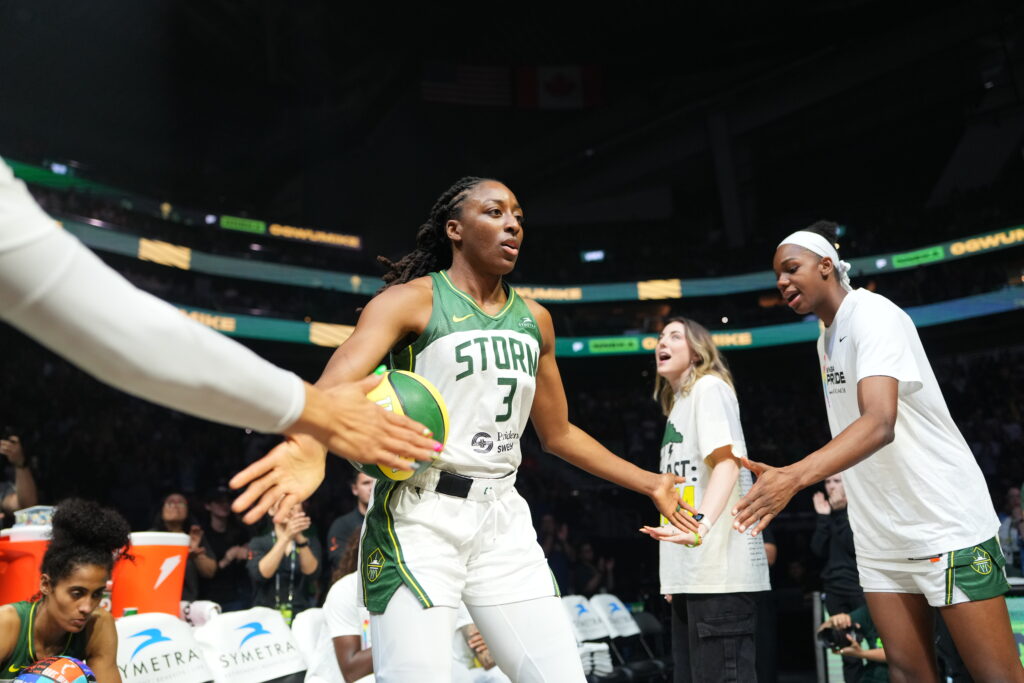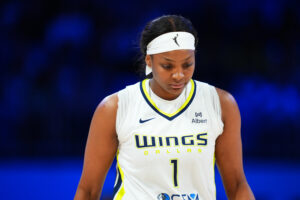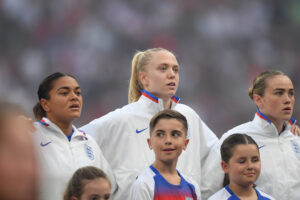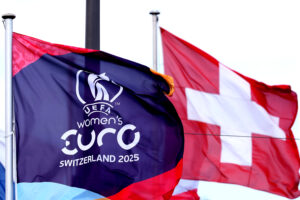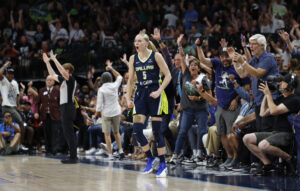When Ariel Atkins learned she had made her first United States Olympic roster, she didn’t know quite how to feel. The 24-year-old Washington Mystics guard erupted in laughter and then fell into tears.
All of the early mornings she spent in the gym before the sun came up, the double workouts she did with her trainer, the baskets she shot until her arms felt like string beans, the late nights of watching film — those moments flashed before her like an old, familiar movie she’s seen at least one hundred times.
“It was just one of those, like, surreal moments, because it’s definitely something that you want and strive for,” Atkins says. “Me being on the U.S. national team is top tier. It’s always the best of the best, it’s always been the best of the best, and it’s a very hard team to make.”
Atkins called her parents and thanked them for supporting her, for being there from the beginning. She sent text messages to friends, family members and mentors. That list included her high school basketball coach, Cathy Self-Morgan. Atkins thanked Self-Morgan for pushing her to get better and for being a special person in her life. The text ended with: “We’re going to the Olympics coach!!!”
The way Atkins responded to the news is the essence of who she is. She wanted all of the important people in her life to know that they had made it, too.
“Growing up, that’s just who she’s been. She’s always had, I guess, a maturity about herself that’s just beyond her age,” says Lashonda Atkins, Ariel’s mother. “I know my mother-in-law used to look at our family photo albums and she would say, ‘She’s gonna be the glue.’ She was always pointing at her saying she’s always the strong one. It’s just who she was.”
To Atkins, it’s always been about the people in her circle and the people in her community. Basketball is secondary. It’s also the reward of those human connections. She did not travel the road that got her to her first WNBA All-Star Game and first Olympics alone.
“(I’m) just super thankful for my circle and my support system,” she says. “They really pushed me to be just a better human overall.”

***
Atkins was in third grade when she first met Self-Morgan at a fifth-grade basketball camp.
“I told her it’s for fifth graders and she said, ‘No, I can do this,’” Self-Morgan recalled. “She proved to me that first day she could do it. Any time I challenged her after that, she could do it. She might look at me kind of with her head cocked sideways, but she’d turn around and she would get whatever job done.”
Self-Morgan coached for 42 years at Duncanville High School in Atkins’ hometown in Texas. She knew Atkins was special and had the potential to make it to the WNBA someday, even the Olympics.
When Atkins was a junior, they were losing to a team at a tournament in Houston by 15 points. Self-Morgan remembers the team laughing at them, and at halftime, she “chewed out” the players hard. It got their attention.
As soon as she turned her back to walk out of the locker room, she heard a voice hyping up the team, holding them accountable. It was Atkins. They ended up winning the game by ten.
“She always lifted up people around her first,” Self-Morgan said. “It got to the point where I would ask her to talk to teammates. When she graduated, I lost an assistant coach.”

As a freshman at Duncanville, Atkins averaged just 3.2 points and 1.8 rebounds. But her game continued to improve year after year, thanks in part to her personal trainer and mentor, Lajeanna Howard. Howard had also played for Self-Morgan at Duncanville. She was coaching college basketball at the University of Louisiana Monroe when Self-Morgan called her to come back and work with the high school team, specifically Akins.
Howard and Atkins connected instantly. They’d get to the gym at 5 a.m. and stay there for hours, sometimes pulling double workouts. Even as a freshman, Atkins didn’t complain. She just put her head down and went to work. And it paid off.
By the time Atkins was a senior, she was averaging 17.9 points, 5.8 rebounds, 4.8 steals and 3.9 assists as the starting guard. She led Duncanville to a 35-1 record and the Texas UIL Class 5A state title game that season, drawing the attention of many top college programs. A 2014 McDonald’s All-American, Atkins was ranked third overall and first overall at her position by ESPN.
Atkins ended up at the University of Texas. The campus was relatively close to home, but the transition from high school to college was a challenge for Atkins. Basketball was harder, the culture was different, academics were tough. At one point, Atkins even thought about transferring and reached out to the people she trusted most for guidance.
“There’s a lot of different adjustments, especially coming from Duncanville in any college program, because you’re so used to being phenomenal,” said Howard. “And you have to adjust to coaching, the setting, not having the people around you that you’re accustomed to having around.”
Self-Morgan doesn’t typically support transferring. She’s an old-school coach who believes that players should push through the hard times because they’ll be better off for it on the other side. But she knew Atkins was struggling, so she decided to look into the situation and reach out to another school.
“The culture at Texas was just different,” Self-Morgan said. “The seniors were the top dogs and the freshman needed to sit down and be quiet. And when Ariel sees things that aren’t right, she’s not going to sit down and be quiet. So that year, in my opinion, she just kept watching as a spectator and being suppressed, and not being able to be who she was and is.”

“I think college was the first time that I was really away from my family,” Atkins said. “I’m a huge family person. I have a really big family. I’m always with them when I’m home or with an aunt, uncle, grandma, grandpa. To not have them with me and to go through those transitions was really tough.”
Atkins eventually changed her mind about transferring and decided to stick it out the rest of her freshman year. She didn’t know it at the time, but doing so would only make her stronger. Especially because WNBA legend Tina Thompson joined the coaching staff as an assistant the following season.
From that moment on, everything shifted.
***
It wasn’t the first time Atkins and Thompson had met. When Atkins was younger, she played in an AAU tournament in Dallas. She was very shy back then and doesn’t remember speaking to Thompson, but she remembers being in awe. Now, Thompson was one of her coaches.
“Anytime somebody approaches me as a human first, I immediately am intrigued and interested in what they have to say, because a lot of times, as athletes, people really approach us as basketball players, as athletes first,” Atkins said. “And even from (Tina’s) first day coming in to (the University of Texas) and just meeting all of us and everything, she approached me as a human more so than anything. And I think that was my first, like, (real) introduction to her.”
The more Atkins grew to trust in Thompson, the more she took her advice and life lessons to heart.
“It’s easier to follow someone who has gone through it before,” she said. “They’ve walked it. So when they talk, you can believe it.”
Unlike a lot of WNBA players, Atkins didn’t really think about making it to the pros. She was always focused on getting better and making it to the next level; basketball was fun and putting in the work made it more enjoyable, but it didn’t go beyond that. It didn’t register with her that her game was evolving to the point where WNBA scouts were starting to take notice.
To her family, friends and coaches, however, Atkins was always destined for the WNBA. Self-Morgan says she knew from the first moment she met Atkins as a third grader. Howard had seen Atkins’ potential, too. And when Thompson arrived at Texas, she told Atkins she had what it took to get there.
“I think it sunk in when she was young, playing in the driveway, because she always said it. Whenever she did some move on her dad and made him look bad, she’d say, ‘Yeah, that’s the WNBA there for you,’” said Lashonda.
Her senior year at Texas, Atkins averaged 14.9 points and 5.5 rebounds and 3.2 assists per game. At 5-foot-8, Atkins had size and strength, and she could score, defend, help out on the boards and put in maximum effort on the court. There was no more avoiding the WNBA’s interest in her. The Mystics scooped up Atkins with the seventh overall pick in the 2018 WNBA Draft.

When she arrived in Washington, the WNBA’s East Coast fan base wasn’t familiar with the guard from the Big 12. Atkins saw it as an opportunity.
“She’s a driven type of person. Whatever she sets her mind to, she’s focused and she’s willing to work for it. She knows she has to work hard,” Lashonda said. “She endears people to her. She knew fans didn’t know her, but she wanted to work hard and show them who she is. She wanted the fans to get to know her.”
Atkins did just that, averaging 22.5 minutes, 11.3 points, 2.1 assists and 1.3 steals per game as a rookie. That didn’t mean the transition from college to the pros was easy. Atkins considers it her biggest basketball lesson to date. She had to figure out how to separate herself and give her team more.
“Like, how do you find your uniqueness? How do you (set) yourself apart?” Atkins said. “I think that’s been, for me, one of the toughest things to do, because I don’t need to step outside of myself. You just need to be yourself a little more.”
That team-first approach has endeared Atkins to those around her, even the most legendary players.
“Ariel’s an utmost professional. She’s one of the most selfless players that I’ve played with in a long time,” said Mystics and U.S. teammate Tina Charles. “She’s equipped with a lot of things that many players her age don’t have, that I didn’t have. So it’s really great to see her maturing into the woman that she is on and off the court.”
Ariel Atkins got the moves 💃 pic.twitter.com/tG2eF6r3jE
— USA Basketball (@usabasketball) July 18, 2021
***
Atkins has never been afraid to use her voice. She’s been active in her community since she was in high school and her mother taught her the importance of giving back. And as her platform has gotten bigger over the years, she’s realized the opportunity she has to speak louder than ever before — particularly when it comes to social justice.
“I think it’s something the WNBA has always done, ever since I became aware of it, even going back to the Minnesota Lynx when they wore the shirts during their warm-up, and then the league fining them for that,” Atkins said. “This league just has a history of women speaking up and speaking out about not only what they believe in, but speaking up for people whose community they’re a part of.”
During the 2020 bubble season, the Mystics walked out of a scheduled game against the Atlanta Dream in solidarity and protest the day after Jacob Blake was shot by police in Kenosha, Wisc. Atkins spoke for her team, telling the Washington Post: “These moments are so much more bigger than us. … If we do this unified as a league, it looks different. … We matter.”
“I had the opportunity to speak and it wasn’t planned or anything by my team, so like, I guess I was the person for the job,” Atkins said “I really call that a God moment because… I was very angry. I didn’t really know what I wanted to say, but I know how I felt, so I was just hoping to hone everything that our team was talking about and what we were all feeling that day and before that day and even to this day, and try to portray that out into the world or whoever was listening at the moment.”
Atkins’ urge to speak up for what she believes is right does not come from a feeling of pressure or responsibility, she says, but a calling based on opportunity. When the moments arise, she feels the need to use her platform for people who need it.
“I have the resources, and if I have the resources, I’m gonna help, you know?” she said. “I think it’s more so in our nature and just who we are as people. There’s s a lot of people in our league that are very caring, that want to help, that are super understanding, and want to empower their community, our community, in the best way that we can.”
Looking back at her evolution from high schooler to Olympian, Atkins says she’s grown in her faith, in her relationship with her family, and her relationship with herself. Along the way, her support system has been everything to her.
Whenever Atkins goes back to Duncanville, she goes to lunch or dinner with Self-Morgan and some of her former high school teammates. Self-Morgan, who retired in 2020, cherishes her connection with Atkins.
“I’m always just thoroughly in awe and supportive, and just one of her biggest fans,” said Self-Morgan. “She is your complete athlete, young lady, person, human being.”
Howard still trains and works with Atkins, and they talk all the time. They watch film, break it down and zero in on areas of improvement. They’re always working on getting better, even when Atkins is overseas.
“When I first met her, she was a kid. I called her kid all the time. But the thing that I can appreciate, and I’m sure that everybody that’s been connected to her as well, is we had the opportunity to grow up and truly be a village and part of someone that is so special,” said Howard. “I just told her the other day, I saw her on the red carpet for (Team USA) and I’m like, ‘Wow — kid, you’ve finally grown up.’ It’s just special to be able to be a part of somebody’s journey and how hard work can really pay off.”

As for Atkins’ family, they are as tight as ever.
”It feels so good,” said Lashonda. “You know, every parent wants the best for their child. Every parent believes in their child, even when their child sometimes don’t feel they believe in themselves. As parents, we always have that belief in them.”
Atkins, who turns 25 this week, has already accomplished so much. With Team USA set to begin Olympic play Tuesday against Nigeria, a gold medal in Tokyo would only add to the list.
None of it changes what Atkins’ primary focus has always been — to be her best self, connect with people and put good out into the world. The secret is that Atkins’ approach to life matters just as much on the basketball court, where there’s always something more to strive for, to put in work for, to achieve.
“We’re still waiting on her to hit a buzzer shot,” joked Lashonda.
Chances are, somewhere over in Tokyo, Atkins is in a gym right now . . . working on it.
